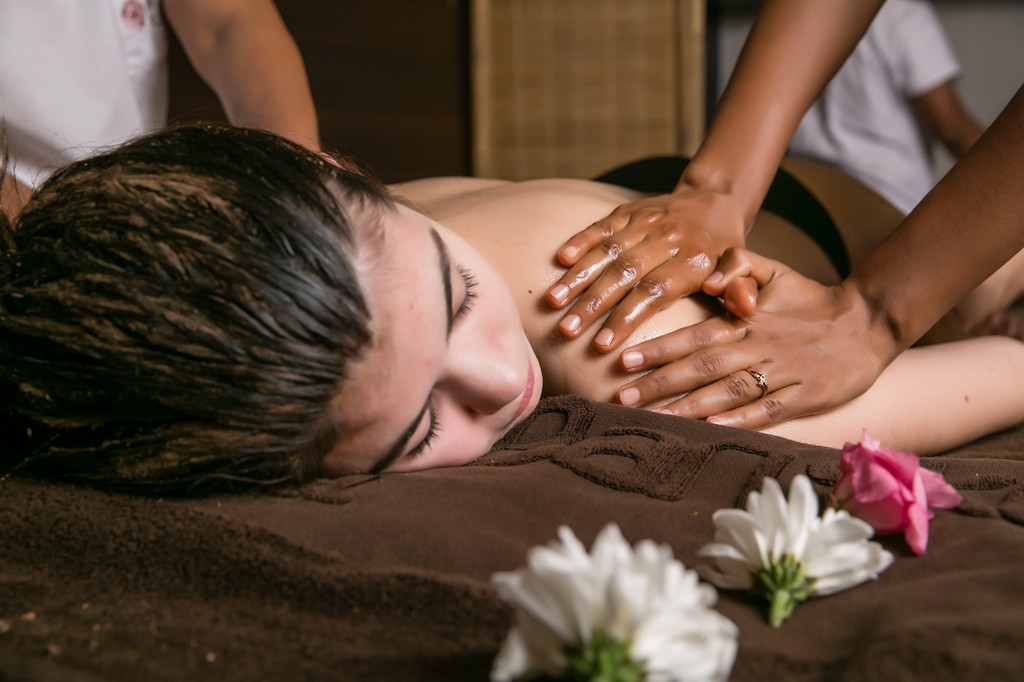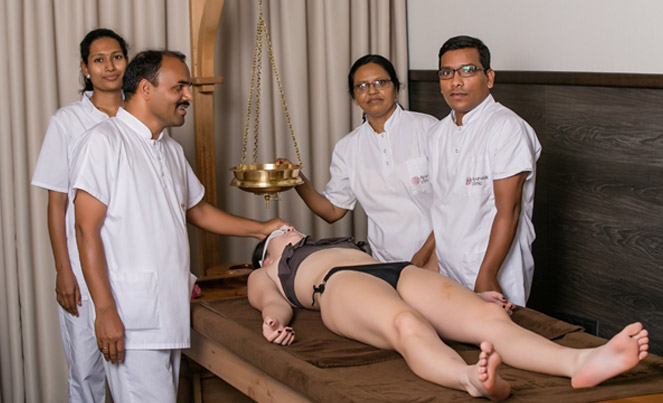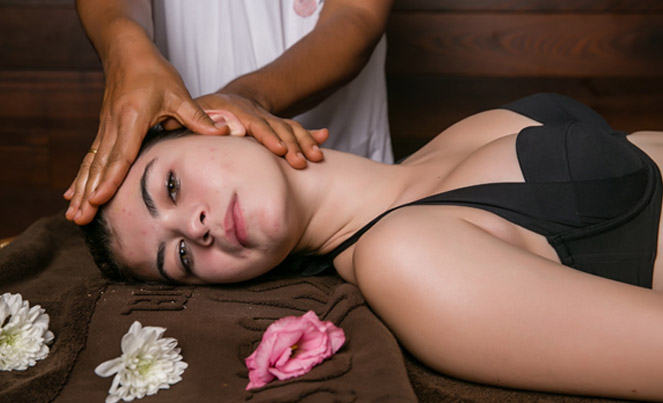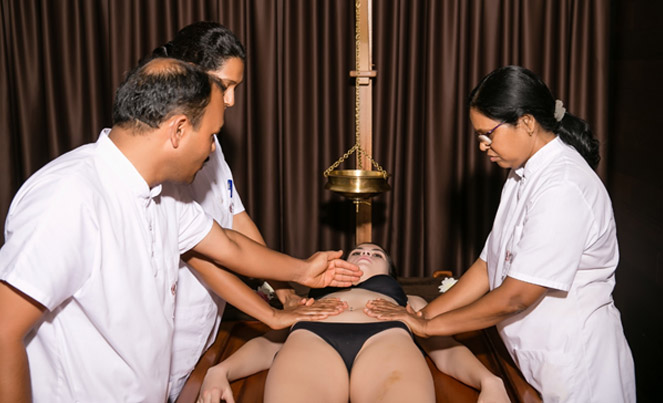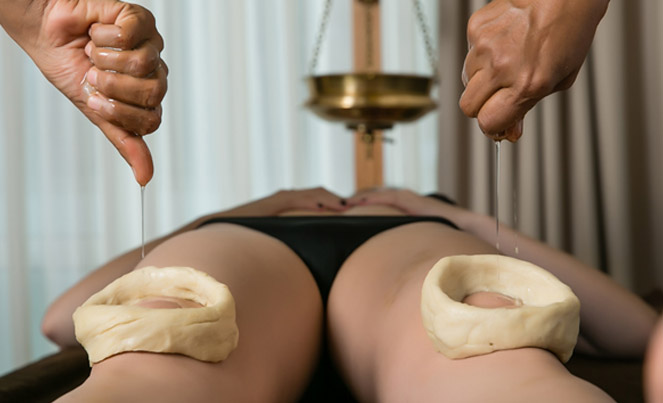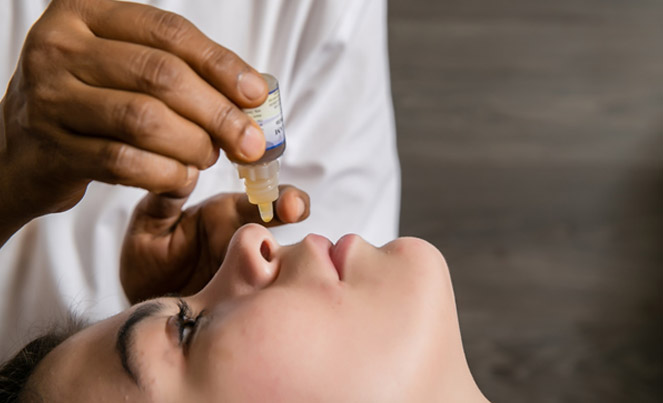Abhyangam – an Ayurvedic massage
The word “abhyangam” means “towards the body” or procedure in the direction of the body.
The application of medicated oils on the head and body is one of the daily practices mentioned in Ayurveda. It is an integral part of our daily life that strengthens our mental and physical health. Processed or medicated oil from sesame seeds is usually used for Vata or Kapha structures and coconut oil for is used for Pitta.
According to the change of seasons, coconut oil is used in the summer and autumn, and in winter and spring sesame oil can be used. Olive oil can be used if you do not have any medicated oil or there are no serious health problems in the body.
In principle, for a country like India (JANGAL PRADESH), Abhyangam can be given daily to people with a Vata structure.
To be applied every two days in people with Pitta prakurti.
It is recommended to give it once a week to people with Kapha.
For countries like Bulgaria or other European countries (ANUP PRADESH) Abhyangam may be given twice a week to people with Vata prakurti.
For people who have Pitta prakurti – it should be given once a week.
It is recommended to give it once every two weeks to people with Kapha.
After the Abhyangam is finished, a warm bath is recommended.
On the day of the massage it is advisable to avoid: cold-water baths, ice cream, cottage cheese, sex, daytime sleep, alcohol, sun exposure and all sorts of exertion.
Benefits of Abhyangam – an Ayurvedic massage
- Abhyangam improves the immune system of the body
- Strengthens the body and helps for a good night sleep
- Helps beat fatigue
- Encourages growth in little children
- Has a rejuvenating effect in elderly people
- Reduces pain
- Helps hair growth and improves sight
Abhyangam as an effect, treatment or procedure means body massage with oil. The way of applying oils (medicated oil specific to the body type) on the body with moderate pressure in certain directions is of paramount importance for Abhyangam.
Normally, in Abhyangam the direction of the oil application is planned in a way so that it will help alleviate tension and pressure on the heart. The parasympathetic nervous system is activated during the Abhyangam procedure. In Ayurveda, this effect is known as “anuloma” and means “away from the heart” or “alertness”.
Benefits of Ayurveda massages
- Strengthening of the blood circulation, helping the blood to reach the nerve endings.
- Toning of muscles.
- They have a calming effect on the brain and body.
- Lubrication of the joints, increase of the strength of the joints.
- Increased mental alertness
- Improves the process of eliminating impurities or toxins from the body with a purifying effect
- Detoxification
- Increases daily endurance levels
- Helps for a better, deeper sleep at night
- Increases longevity
- Strengthens vision
- Improves skin health, removes wrinkles and gives radiance
- Nourishes your body
- Helps the growth of your hair by making it thick, soft and shiny
- Refreshes and soothes sensory organs
- Removes facial wrinkles
- Alleviates roughness, stiffness, fatigue and coarseness
Types of Ayurvedic massages
- Murda taylam – oil application on the head.
- Shiro abhyangam – applying oil on the scalp.
- Siro pitchu – putting an oil-soaked cloth over the head.
- Shiro vasti – keeping the oil on the head for a certain period of time using a hat.
Shiro abhyanga – massaging the head with oil. The most commonly used head massage oils are:
- For balancing of Vata – danvantaram oil
- For balancing of Pitta – kshiraballa, asana manjishtadi thailam
- For balancing of Kapha – Nirgundi oil, Surasadi oil, Eladi thailam
Benefits of shiro abhyangam
- Beneficial for the sensory organs
- Beneficial for the eyes
- Regulates prana
- Induces sleep
- In conditions such as a dry, itchy scalp,
- cervical spondylosis or spondylitis
- Conditions such as migraine headaches,
- sinusitis,
- any type of diseases of the ears and
- conditions such as disturbed sleep, etc.
Marma therapy
The word “marma” means “vital energy points of the body”. In the human body, there are 107 anatomical structures in which we can find a combination of nerves, blood vessels, bones and joints. These points are highly sensitive areas of the body; any type of external or internal impact can cause serious injury or death to the person. This anatomical structure is known in Ayurveda as marma.
With understanding the importance of such type of a structure in the body, Ayurveda develops a very special branch of treatment, called marma chikitsa. By comparing the physical complaints of a person, the Ayurveda physician can detect the affected problematic marma in the body.
Once the spot is determined, special massages are performed on the marma with trained hands in order to remove the obstacle from the marma. All of the mentioned procedures,like svedana, snehana, pizichil, are performed to restore health in the marma points.
There are 22 marmas on the lower limbs, 22 on the arms, 14 are on the back, 12 on the stomach and chest and 37 are located on the head and neck.
Use of marma chakitsa.
- Removes obstacles from the path of the energy flow in the body. It’s a type of cleansing marma therapy
- which improves the neuromuscular junction of the body by increasing sensitivity.
- Reduces body stiffness.
- Gives strength to the mind to stretch the limits.
Aspect of the treatment
- Marma treatment affects all aspects of the neurological disorders.
- It is a type of stimulant for the body cells causing them to regenerate the lost strength.
- Conditions such as paralysis and arthritis can be well influenced by the marma treatment.
Shiro Dhara
It is also called shiro pariseka. By choosing different liquids we can cure many diseases.
For example:
- Oils are used for the treatment of disorders in Vata.
- Milk, ghee or coconut water is used to treat imbalance in Pitta
- For treatment of Kapha – buttermilk, danyamalam, alcohol (fermented liquid made from cereals)
- Dhara – can be applied on the head, the whole body or locally.
General indications
- Mental disease
- Chronic sinusitis
- Cerebrovascular disease
- ENT diseases
- Diseases of the nervous system
- Psoriasis
- Migraine headache
Dhara vessel
- The vessel must be made of copper, stainless steel, wood or clay. Its capacity should be 3 liters and it should have a hole of 1 cm on the bottom.
- It must be shallow, 15-20 cm deep and with a wide opening.
- It has to be hung on the stand.
- It should be 3 to 4 inches above the patient’s forehead.
Shiro Dhara Procedure
- Two doctors are needed for the treatment.
- One to oscillate the vessel and the other to collect and prepare the medicine
- Pray and begin treatment
- Allow the patient to lie down on the table in supine position and cover their eyes
- Make an Ayurveda massage with oil on the head and body
- If necessary, support the neck with a pillow
- Make sure that the medicine falls exactly on the forehead between the two eyebrows.
- Duration – from 35 to 90 minutes for 3, 7, 14, 21 days (as needed).
Takra dhara ayurvedic massage
The Takra dhara is especially useful for diabetic neuropathy, migraine, anxiety, psoriasis, etc. It is used to treat diseases of the ears, nose and throat.
Medicines for Takra Dhara
- Make the decoction with 1.5 L of milk and musta. Then let ferment over night.
- On the next morning churn the yogurt. Remove the butter and separate the buttermilk.
- Add 1.5 L of amalaki kashayam.
- The liquid is used for Shiro dhara
- Likewise, yastimadu, candana, usira can be used.
- Aragvada kasayam – also used in skin diseases.
- Ksira Dhara is used in Pitta conditions.
Use of Ksira Dhara
- Prepare milk with a decoction of of bala and satavri (1.5 L)
- Add 1.5 L of coconut water to it and perform dhara.
- After dhara, take a bath with warm water and apply rasnadi churnam on the head.
Siro pitchu
This Ayurvedic massage is done by placing a piece of cotton or cloth soaked in medicated oil. Widely used in conditions of hair loss, stinging in the eyes, psoriasis and many mental disorders.
Siro vasti
- This is the best Ayurvedic massage to nourish all sensory organs.
- It is applied in cases of facial paralysis, psychiatric problems, eye diseases, chronic headaches and various neurological problems.
- It’s done after the cleansing therapies.
- The patient’s hair should be cut or shaved.
- It is done in the evening or at night.
- It’s done in a sitting position.
- The oil should not leak from the head
- A leather hat with a height of 10-12 inches is placed on the head.
- Warm oil is poured into the hat to a height of 1-2 inches.
- During this time, the patient should not shake their head, laugh or sneeze.
- The patient should retain the oil until Kapha appears n the ears, nose and mouth or painful symptoms subside.
- For Vata: 30 to 40 min.
- For Pitta: 20 to 30 min.
- For Kapha: 15 to 20 min.
- For people with no health problems: 10 to 15 min.
- After that the shoulder back and neck are massaged well and a warm water bath is given
- Rasnadi churnam is applied after that
Types of Pinda Sveda (Potli)
- Sastika Pinda Sveda – made from fermented rice balls
- Patra Pinda Sveda – made from a herbal leaves
- Curna Pinda Sveda – herbal powder
- Jambira Pinda Sveda – a mixture of lemon and herbal powder
- Mamasa Pinda Sveda – goat meat and herbs
- Godhuma Pinda Sveda – cooked wheat
- Karpas Pinda Sveda – a compress of cooked cotton seeds
Sastika Pinda Sveda
- This is a type of rice cooked with milk and herbal juices.
- Cooked rice made into balls and placed on body parts.
- The balls are between 200 g and 300 g.
- It is mainly used in Vata diseases and neuromuscular diseases as well as for rejuvenation.
- It is used as a cosmetic procedure as well as a general healthy rejuvenation.
Patra Pinda Sveda
- Balls are made of the leaves of calotropis, tamarind, datura and cas which are processed in a coconut scraping, lemon pieces, garlic and oil. They must be placed all over the body.
- Used in rheumatism and Vata diseases.
- Useful in cases of osteoarthritis and “frozen shoulder”.
- It also helps deal with pain.
Sveda procedure
- It is usually done in the morning hours after applying oil.
- It may be mild, moderate or strong according to the disease.
- During sveda protect the eyes, scrotum and heart.
- On these areas of the body only a mild sveda should be applied.
- If there is ama (digestive toxins), sveda is done without oil by exposing the person to sunlight, advising exercise, etc.
Signs of a properly performed svedana
- Disappearance of the feeling for cold and pain.
- Softness, alertness, free movement of the joints, normal skin, normal appetite, etc.
- If done in excess, Pitta and rakta will be violated.
- Thirst, dizziness, pain and rashes can manifest.
- In this case, a cooling therapy should be applied.
Contraindications to svedana
Warm waves, bleeding hemorrhoids, nose bleeds, heart diseases
Kaya seka (Pizichil)
- It’s a combined process of snehana and svedana in which medicated oil is poured all over the body in a stream at a height of 4 inches from the body and massage is done. The oil should be changed every three days.
- It is prescribed for Vata rogas and has a rejuvenating effect.
- For Vata- Dhanwantar, Karpasastayadi, Bala asvagandha laksadi
- For Pitta – Ksirbala, Pinda Tailam, Narayana Tailam
- For Kapha – laksadi, pankasneham
- In case of loss (of tissues, muscle mass) – Laksadi, Pancasneham
- For the skin – Manjishtadi, Aragvadadi, Nalpamaradi
Usually 5 to 6 liters are needed. The oil should be changed every three days. After the procedure, a hot water bath is given and Green gram powder is used to remove excess oil from the body.
Vasti (therapeutic enema)
Vasti is part of Panchakarma in which medicated oil or decoction is introduced through the anus, urethra or vagina.
Nirkuti (definition)
“Vasti” means “a place to stay”. Medicated oil is retained or remains in or on a part of the body without external interference. Once the medicine is placed, it must remain still without any movement. In general, the word “vesti” is used in the sense of “enema” for better understanding.
In Uttara vasti, the medicine reaches the bladder or the uterus.
Significance of vasti
- This is the best treatment for diseases caused by Vata energy.
- It’s the direct treatment of Vata in its vital seat (the colon).
- It is called ardha cikitsa (half-treatment) or sarva cikitsa (full treatment).
- It has multidimensional utility, unparalleled pharmaco-kinetics and choice
Vasti Classifications
- Adi sthana bheda (according to the body area)
- Dravya bheda (according to the medicine used for the vasti procedure)
- Sankya bheda (according to the number of cycles or repetitions of the procedure)
- Matra bheda (according to the amount of medicine used in the procedure)
Indications of Kashaya vasti
- Pain with different aetiology in the lower back.
- Infertility
- Rheumatic syndrome and other arthropathies
- Neurological deficits.
- Irritable Bowel Syndrome (IBS)
- Chronic rhinitis
- Multiple sclerosis
- All Vata diseases
Indication of anuvasana vasti
- Atiruksha (very dry)
- Atyagni (acute digestive fire)
- Vata disease
Madhutaylika vasti
This is a type of kashaya vesti
Honey and oil are used as ingredients for the preparation of the procedure.
It’s has numerous names
- Sidha vasti
- Yapana vasti
- Yuktarata vasti
- Sigda vasti
- doshahara vasti
Indications
- Premaham (urinary, metabolic and diabetic disease)
- Krumi (intestinal worms)
- Gulmam (benign massive lesions of the gastrointestinal tract)
- Antra vrudhi (inguinal disease)
- Udavartam (reverse peristalsis)
Benefits
- Minor side effects
- It can be given in case of mrudukosta (soft stools)
- Moderate action and safe to use
- It can be used for an extended period of time
Action
- Dipanam – stimulates digestive activity
- Brmanam – nutritious
- Rasyanam – rejuvenating
- Kaksusyam – beneficial for the eyes
Signs of a successful enema treatment
- Proper and complete evacuation of stools and drugs
- A sense of purification
- Feeling of lightness
- Improves appetite and digestion
Janu vasti
Janu vasti is a special treatment applied in cases of degenerative condition of the knee joint.
Procedure:
The aim is for the knee joint to be soaked with oil through a special Ayurvedic procedure.
Advantages:
It is a good alternative treatment for people who want to avoid a knee replacement surgery.
Uro basti o hridya vasti
Uro basti is also called hridya vasti.
This is a special treatment to give strength to the organs in the chest – lungs and heart.
Procedure:
Using a special Ayurvedic procedure, medicinal oil is applied to the chest or center of the nipples.
For good results this procedure is repeated for 5 to 14 days.
Advantages:
It is strongly recommended in all types of heart diseases Strengthens the heart, muscles and nerves.
Nasya
- This is administration of drugs through the nose. It is also called navana.
- Its applied in diseases of the area above the shoulders, the nose being the gateway towards the head.
- It is performed daily as a preventive measure (dinacherya).
Types of nasya
- Virechana
- Brmhana
- Shamana
- Virechana Nasya – it is performed in all Kapha diseases, such as: sinus congestion, cerebral edema, nasal block, stiff neck, hoarseness of the voice, etc.
- Brmhana Nasya – used in Vata disease, such as: migraine headaches, tinnitus, deafness, Insomnia, cervical spondylitis, disorders consisting of involuntary movements.
- Shamana – it is performed in case of Pitta diseases, such as: hair, pigmentation, hemorrhagic disease. Medicines used: Milk or Annu Tailam
There is one more type of nasya and that is:
- Pratimarsa Nasya – it is performed with 1 or 2 drops of oil every day. Usually done in children, weak people and on rainy days. It can be done in the morning after breakfast, bath, exercises, etc.
Contraindications for nasya
- Fatigue
- Acute respiratory infection
- Immediately after food ingestion
Symptoms of a properly performed nasya
- Normal breathing
- Sneezing
- Lightness of the sense organs
- Good sleep
- A normal sense of taste and digestion

